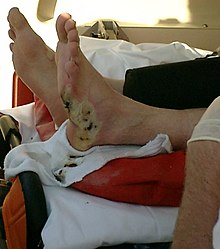Electric shock
| This article needs additional citations for verification. Please help improve this article by adding reliable references. Unsourced material may be challenged and removed. (December 2007) |
1700 volts burns a grounded hot dog
Safety rule #1 - Remove the voltage before any action at electrical wiring

 The minimum current a human can feel depends on the current type (AC or DC) and frequency. A person can feel at least 1 mA (rms) of AC at 60 Hz, while at least 5 mA for DC. The current may, if it is high enough, cause tissue damage or fibrillation which leads to cardiac arrest. 60 mA of AC (rms, 60 Hz) or 300–500 mA of DC can cause fibrillation.[2][3] A sustained electric shock from AC at 120 V, 60 Hz is an especially dangerous source of ventricular fibrillation because it usually exceeds the let-go threshold, while not delivering enough initial energy to propel the person away from the source. However, the potential seriousness of the shock depends on paths through the body that the currents take.[2] Death caused by an electric shock is called electrocution.
The minimum current a human can feel depends on the current type (AC or DC) and frequency. A person can feel at least 1 mA (rms) of AC at 60 Hz, while at least 5 mA for DC. The current may, if it is high enough, cause tissue damage or fibrillation which leads to cardiac arrest. 60 mA of AC (rms, 60 Hz) or 300–500 mA of DC can cause fibrillation.[2][3] A sustained electric shock from AC at 120 V, 60 Hz is an especially dangerous source of ventricular fibrillation because it usually exceeds the let-go threshold, while not delivering enough initial energy to propel the person away from the source. However, the potential seriousness of the shock depends on paths through the body that the currents take.[2] Death caused by an electric shock is called electrocution.If the voltage is less than 200 V, then the human skin, more precisely the stratum corneum, is the main contributor to the impedance of the body in the case of a macroshock—the passing of current between two contact points on the skin. The characteristics of the skin are non-linear however. If the voltage is above 450–600 V, then dielectric breakdown of the skin occurs.[4] The protection offered by the skin is lowered by perspiration, and this is accelerated if electricity causes muscles to contract above the let-go threshold for a sustained period of time.[2]
If an electrical circuit is established by electrodes introduced in the body, bypassing the skin, then the potential for lethality is much higher if a circuit through the heart is established. This is known as a microshock. Currents of only 10 µA can be sufficient to cause fibrillation in this case.[citation needed] This is a concern in modern hospital settings when the patient is connected to multiple devices.


